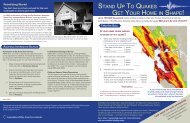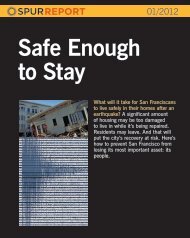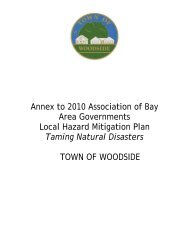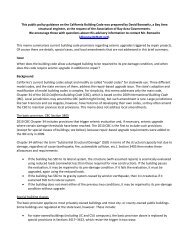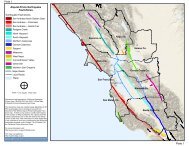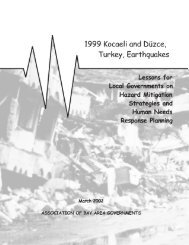Airport Liquefaction Susceptibility Analysis Report - ABAG ...
Airport Liquefaction Susceptibility Analysis Report - ABAG ...
Airport Liquefaction Susceptibility Analysis Report - ABAG ...
Create successful ePaper yourself
Turn your PDF publications into a flip-book with our unique Google optimized e-Paper software.
Fugro Consultants, Inc.<br />
Project No. 04.79221200<br />
soils. Additionally, even if the soil does not fully liquefy, dissipation of excess pore pressure<br />
following the earthquake can result in soil compression and settlement.<br />
The susceptibility of soil to liquefaction is a function of gradation, density, fines content, and<br />
plasticity of fines. Increases in grain size distribution, soil density, fines content, and plasticity<br />
index decreases the susceptibility of soils to liquefaction. In addition, the liquefaction<br />
susceptibility of soils also decreases with respect to the age of the deposit and effective<br />
overburden stress.<br />
The liquefaction susceptibility of the soils was assessed following state of practice analysis<br />
methodology using simplified empirical SPT and CPT based procedures (e.g. the Simplified<br />
Procedure). Due to its widespread application, multiple revisions of these Simplified Procedures<br />
have been developed and reported over time (e.g. Seed et al., 1982, 1983, 1985; Robertson<br />
and Wride, 1997; Youd et al., 2001; Idriss and Boulanger, 2004, Cetin et al., 2004b). The<br />
approach recommended by Youd et al. (2001) is currently one of the predominant approaches<br />
adopted in the state of practice and has been selected for this study as it provides<br />
recommendations for both the SPT and CPT based liquefaction susceptibility approaches.<br />
In order to perform the liquefaction assessment, two variables need to be estimated: cyclic<br />
stress ratio (CSR), which characterizes the seismic demand on the soil, and the cyclic<br />
resistance ratio (CRR), which characterizes the soil capacity in resisting liquefaction. A factor of<br />
safety against liquefaction is then calculated as a ratio of CRR and CSR.<br />
CSR is estimated using input ground motion characteristics, peak ground acceleration (PGA)<br />
and earthquake magnitude (M). The selection of PGA and M values is discussed in the following<br />
section. CRR is calculated using SPT blow count values or CPT cone tip resistance corrected<br />
for overburden stress and fines content. The relationships between CRR and corrected SPT<br />
blow count or CPT tip resistance have been developed by Youd and others (2001) through a<br />
review of historical cases of liquefaction occurrence.<br />
In addition to calculating a factor of safety against liquefaction, our assessment also includes<br />
evaluation of liquefaction-induced reconsolidation settlements. <strong>Liquefaction</strong>-induced settlements<br />
were calculated using Ishihara and Yoshimine (1992) recommendations. It should be noted that<br />
the soil above the groundwater can also settle due to dynamic compaction, however, we have<br />
not included dynamic compaction settlements as part of this study.<br />
5.1.1 Ground Motion Parameters<br />
<strong>Liquefaction</strong> susceptibility analyses were performed for five sets of ground motion parameters<br />
corresponding to the following deterministic and probabilistic scenarios:<br />
• 1906 San Francisco Earthquake Scenario (Deterministic median)<br />
15<br />
May 31, 2013



